A rifle scope for shooting at 300 yard should be slightly more powerful than one used for shorter distances, such as under 200 yards.
Numerous options on the market are powerful enough to be used over these distances. This article reviews the best of them, which will not only give you good performance over 300 yards but will also give you the best value for money.
Best Rifle Scope for 300 Yards-Top Picks
| Product | Image | Best Prices |
| Vortex Diamondback 4-16x44mm | 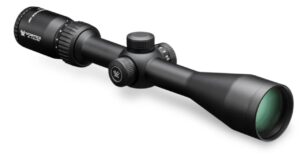 |
|
| Leupold VX-Freedom 3-9x40mm | 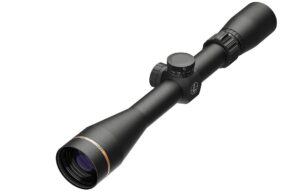 |
|
| Leapers UTG 3-12x44mm Compact | 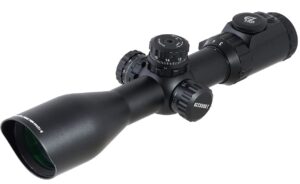 |
|
| Athlon Optics Talos 3-12x40mm | 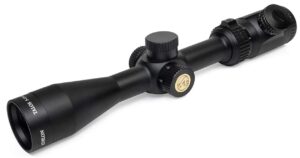 |
|
|
Nikon Buckmasters II 3-9×40 BDC
|
 |
|
| Bushnell Banner 3-9x40mm | 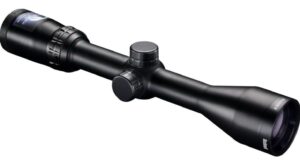 |
|
| Trijicon AccuPoint TR-22 2.5-10x56mm |
The detailed reviews…
Vortex Diamondback 4-16x44mm scope

Apart from the reputation it brings from vortex this scope gives so much more when it comes to performance. it gives a high magnification of 16x without a decline in the quality of the image or any resulting dark edges. The scope can be used in a wide array of applications like hunting, and competitive shooting over long-range targets.
This is because its dependable to give the user accuracy, moreover, the high-quality extra-low dispersion glass, and multi-coated lenses ensure a bright image all the time.
The scope utilizes a First focal plane which is typically renowned to be more expensive than the second focal plane. But this is not the case here. It ensures that users enjoy the capabilities of an FFP, of the reticle adapting to magnification while keeping the costs affordable. You also get numerous adjustments that can be made smoothly and with ease.
Features
- Objective Lens Diameter: 44 mm
- Magnification: 4 – 16 x
- First Focal Plane (FFP) reticle
- Field of view: 6.7 – 26.9 ft at 100 yds
- Eye Relief: 3.8 in
- Dimensions: 14 x 4 x 2.01 in.
- Fully Multi-Coated lens
- Weight: 23.1 oz
Pros
- Numerous easy-to-make adjustments
- Uses a first focal plane (FFP)
- Fairly lightweight
- The high magnification aids the placement of shots
- Good quality image
Cons
- The FFP may not appeal to everyone
Leupold VX-Freedom 3-9x40mm Rifle Scope

This scope made in the USA is a rugged alternative that will withstand a reasonable amount of abuse in the wilderness. What stands out however is that the scope is available with the Custom Dial System (CDS). A unique feature from Leupold that matches your reticle to the exact ballistic, and the most common range of your targets.
Once you have the reticle in place target acquisition is simple, and the additional adjustments like windage can be easily made using just your finger.
The scope also stands out for having a decent eye relief of 4.2, when in low magnification. This slightly reduces to 3.7 when you advance to 9x which is the sweet spot for a typical shooter to acquire a target at a distance of 300 yards. Sighting in the scope is simple, and its lightweight design makes it easy to move for shooters to scour their targets in the deep woods.
Features
- Objective Lens Diameter: 40 mm
- Magnification: 3 – 9 x
- Second Focal Plane (SFP) reticle
- 1/4 MOA Finger Click adjustments
- 1 – 13.6 ft at 100 yds field of view
- Eye Relief: 4.2 – 3.7 in
- Weight: 12.2 oz
Pros
- It’s lightweight
- The CDS feature makes targeting easier
- Easy to make adjustments
- Decent eye relief
- Rugged exterior
Cons
- The 9x maximum magnification may not favor a novice over 300 yards.
Leapers UTG 3-12x44mm Compact Rifle Scope
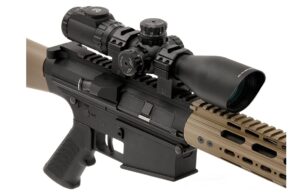
The brand of this rifle scope has slowly perfected the art of making good optics, and the proof can be seen when you use this rifle scope. This particular model gives one of the best image clarities, which makes it dependable, and one of the best rifle scope options for use at 300 yards. Its also very compact for those who dislike a rifle scope with unwieldy dimensions.
This good clarity is the multi-emerald lens coating that has been applied to the lens. moreover, it uses an illuminated reticle with different color options, and 7 levels of brightness, to accommodate all lighting conditions.
Another reason to consider this scope is the convenient adjustments that it comes with. Firstly, you can smoothly adjust for parallax using a wheel located on the side. The turrets also zero resets after every shot, to help you accurately plan for your next one.
Features
- Objective Lens Diameter: 44 mm
- Magnification: 3 – 12 x
- Second Focal Plane (SFP)
- Illuminated reticle
- 10 – 32 ft at 100 yds Field of View.
- Eye Relief: 3 – 3.4 in
- Battery Type: CR2032
- Weight: 23.1 oz
Pros
- The illuminated reticle is visible
- Easy to make the adjustments to the turret
- Excellent image clarities
- has an integrated front sunshade with flip open lens cap
Cons
- It isn’t easy to sight in the scope
Athlon Optics Talos 3-12x40mm Rifle Scope

This rifle scope has been constructed carefully and in detail, you might confuse it with a more expensive option. It’s stylish and uses advanced materials, that make a tough alternative. The lens is fully coated to increase light transmission and gives the user a clear image, even under low light.
It comes with an illuminated reticle that helps with clarity irrespective of the lighting conditions. This means that it can be used both in the open fields and in dense thickets for hunting. moreover, you get the option to choose between a MIL and MOA reticle both of which are optimized for accuracy, in their markings and the design of the center.
Overall, this is an excellent choice if you want excellent value, which results from its low price in comparison to its performance.
Features
- Objective Lens Diameter: 40 mm
- Magnification: 3 – 12 x
- Second Focal Plane (SFP)
- Illuminated reticle
- 9 – 34.1 ft at 100 yds Field of View.
- Eye Relief: 3.35 – 3.82 in
- Capped turrets
- Weight: 16.2 oz
Pros
- Affordably priced
- Fairly lightweight
- MIL and MOA reticle options
- Excellent low-light performance
- Decent eye relief
- Premium design
Cons
- The control knobs are stiff and hard to use
Nikon Buckmasters II 3-9×40 BDC rifle scope 
This rifle scope isn’t popular with many shooters but the few of them who have used it will give a testament to its excellent capabilities. The clarity through the lens is out of this world, in addition, you get a Nikon no-fault lifetime warranty to assure you that it will not break soon.
The scope gives you a 9x maximum magnification which is more than suitable for a typical shooter, who wants to make an accurate shot over 300 yards. Moreover, the lightweight of 0.8 lbs. makes it a preferred option if you move a lot in the field.
Accuracy has also been prioritized, with the inclusion of a bullet drop compensation (BDC) reticle and an easy-to-adjust reticle that provides the user with a positive click as feedback.
Features
- Objective Lens Diameter: 40 mm
- Magnification: 3 – 9 x
- Second Focal Plane (SFP) reticle
- 1/4 MOA adjustments with positive click
- 8 – 11.3 ft at 100 yds field of view
- Eye Relief: 3.6 in
- Weight: 13oz.
Pros
- Excellent quality images
- Lightweight and easy to carry
- Lifetime warranty
- Easy to aim with the BDC reticle
- Finger adjustable turret
Cons
- Isn’t as rugged as some other alternatives
Rifle scope for 300 yards-Buying Guide
These are the characteristics to look for when selecting the best rifle scope to use for a 300-yard target.
Magnification is intended to make a target appear closer than it is, and it is critical to select a point of aim on the target that is extremely distant. However, high magnification does not always imply that the shooter will hit the target.
Although a larger target necessitates a higher magnification, it is the skills that matter, and a pro may require less magnification than a novice to shoot at the same target.
A typical shooter would need about 5x to 7x magnification to shoot at a target that’s 300 yards out. Others may need more magnification like 9x. It’s noteworthy, however, that a slight movement away from the target usually results in a bigger miss when using a higher magnification.
Adjustments-300 yards is a fairly long distance, and hitting the target will necessitate a few adjustments. A good scope should be simple to zero in on, as well as simple to adjust for windage and elevation.
If the scope hasn’t already been adjusted for parallax, which is more likely to occur over long distances, the scope should make it easy to do so.
Image quality-This depends on three things; first the type of glass, the number of coatings that have been applied on the surface, and the diameter of the objective lens. Unfortunately, better glass quality comes at an added price, for the scope.
Glass coatings are applied to reduce reflective loss of light, and to increase the amount of light entering through the lens. One should look for descriptions like ‘multi-coated’ lenses to know that the lens has numerous coatings.
The amount of light that passes through the lens is affected by the objective lens diameter. Because it can trap more light, a wide objective lens performs better in low light. A larger objective lens, on the other hand, makes the rifle scope bulky and unwieldy. If you have to make a lot of movements in the field.
Eye relief– This is the maximum distance between the shooter’s eye and the observation end of the scope at which the image of the target is fully visible with no distorted edges.
Longer eye relief is advantageous for those who wear glasses or who use a weapon with high recoil that flies backward after each shot. A weapon aimed at a target 300 yards away will have fairly high recoil, necessitating at least 3 inches of eye relief.
Durability– Amid the harshness that characterizes the outdoor environment, you require a scope that will withstand it and be dependable in the long run. Manufacturers have incorporated various protective mechanisms, such as weather resistance, impact resistance, and recoil resistance. A good rifle scope should have a slew of these safeguards.
Rifle Scope for 300 Yard FAQs
Difference between the first focal plane and the second focal plane?
The only difference between these scopes is how the reticle behaves in relation to the magnification. On the second focal plane (SFP), the size of the reticle does not change with magnification. This is because the reticle is located behind the magnification lenses.
On The first focal plane (FFP) the size of the reticle increases and decreases, consecutively with the increase and decrease of magnification. The reticle is located after the lenses.
The one advantage of an FFP is that it denotes the correct value at all magnification levels while the SFP is only accurate at one level of magnification, and requires the shooter to make calculations to capture the other levels of magnification.
What magnification do you need for 300 yards?
For 300 yards, a magnification range of 4x to 10x is deemed appropriate. The best magnification is also determined by the size of the target, and it should provide you with the ideal balance of field of view and ability to precisely identify targets. Consider opting for a variable magnification for it will give you the versatility to adjust with changes in the distance of the target.
What objective lens size is ideal for 300-yard shots?
An objective lens size of 30-40mm will give you sufficient brightness and clarity without adding too much weight to your rifle. A larger objective lens can be used for better low-light performance but it isn’t necessary for a 300-yard distance.
CONCLUSION
After reading this article, you will be familiar with the best rifle scope to shoot 300 yards. These scopes not only provide good performance over such distances, but they also ensure that you don’t waste money on something that isn’t worth it.
This article also provides an in-depth look at the characteristics to consider when selecting a rifle scope. Overall, pick up any of these rifle scopes and start shooting at your favorite targets. Best of luck!
Related
